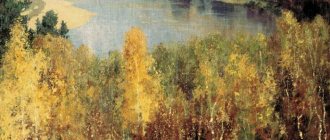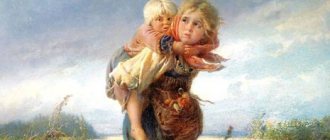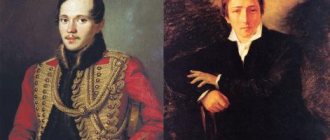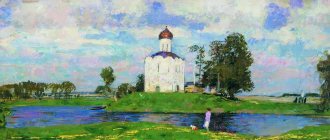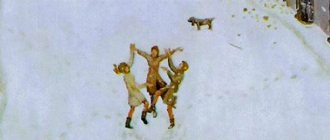Essay based on the painting “Haymaking”, Plastov
Author: Alexey, 4th grade
In front of me is a painting by A.A. Plastov "Haymaking". It belongs to the landscape genre. First I paid attention to nature. The July sun is shining in the sky and the breeze is blowing. There are bright flowers all around, their delicate aroma wafting. Birds sing their catchy songs. Birch trees shake with a magnificent shock of branches.
There are people in the picture, they are mowing hay. The peasants are very hardworking. They cut hay to feed their livestock. Even though the peasants are tired, they still continue to work. You can't last long without hay. This is a chance to survive in bad times.
I really liked the picture. It glorifies the Russian people as a working and strong people. With this painting the author expresses his great love for the Motherland and its people.
Essay based on Plastov’s painting: Haymaking
Author: Angelina, 4th grade
I see in front of me a picture of A.A. Plastov "Haymaking". I immediately drew attention to the peasants. A dry breeze is blowing, the scorching July sun is shining, there is the aroma of mown grass and wildflowers, and butterflies are fluttering around them. The beautiful birch trees are standing, the birds are chirping. Against the backdrop of complete harmony and beauty of nature, peasants work with all their might. Not only old people work, but also young people. Nobody is idle, everyone must work, because now is the post-war period. You need to feed your livestock to survive the winter.
I really liked the picture, because in it the author showed the peasants how they survived in such a difficult time for everyone, they worked from dawn to dusk. This picture is a real example of love for the Motherland.
Essay based on the painting by A. A. Plastov “Haymaking”
Essay based on the painting by A. A. Plastov “Haymaking”
Arkady Aleksandrovich Plastov (1893-1972) was born in the village of Prislonikha in the Simbirsk province (now Ulyanovsk region) into a peasant family. Interest in painting, apparently, was passed on to the boy from his grandfather, who was an icon painter.
For some time, Plastov assumed that he would become a priest. After 3 years of studying in a rural school, he entered the Simbirsk Theological School, then the Simbirsk Theological Seminary. But the thirst for art, apparently, did not leave the young seminarian. In 1912, the young man left for Moscow. At first he attended classes in the studio of the artist I. I. Mash-
Kova, then entered the Imperial Stroganov Central School of Art and Industry, where he studied for 2 years. After this, Plastov entered the School of Painting, Sculpture and Architecture, but not in the painting department, but in the sculpture department. Among his mentors were famous masters - sculptor S. M. Volnukhin, artist A. M. Vasnetsov and others.
The young artist returned to his native village in 1917. Here he constantly drew from life, depicting his fellow villagers, their holidays and everyday life.
Plastov’s paintings are characterized not only by high skill and knowledge of the life of the Soviet village, but also by love and attention to the people who live and work in the countryside. Features of Plastov’s paintings are genre scenes always unfolding against the backdrop of a landscape, lyrical expressiveness without plot tension.
During his lifetime, the artist became a recognized classic of Soviet painting; reproductions of his paintings began to be placed in school textbooks and anthologies.
In the painting “Haymaking,” the artist depicted how a family performs one of the types of agricultural work—cutting grass for hay. Harvesting hay is no less important than successfully harvesting grain - otherwise the livestock will have nothing to eat during the long, cold winter. Like all rural work, in the old days haymaking was accompanied by special rituals; many proverbs and sayings are dedicated to it.
Haymaking was considered a kind of holiday; people wore the best clothes and sang songs while working. In the old days it was customary for the whole village to mow. The best time for making hay was considered to be the period from Peter's Day (June 29) to Proclus (July 25).
For mowing, a special tool called a scythe was used - and is still used today. On a long wooden handle - like for shovels, rakes, etc. tools - a long, slightly curved blade is attached. Holding the handle, they swing widely and cut the grass with the inside of the blade. Working with a scythe requires skill and considerable caution, since the blade is sharp.
In Plastov’s painting, it’s not the whole village that is being mowed down, but only 4 people. Most likely they are members of the same family. They are dressed simply, probably in their usual everyday clothes. The teenager, who is depicted closest to the viewer, is generally only wearing pants, he took off his shirt - maybe because it’s hot, or maybe he’s protecting it.
It is unknown whether these people have holiday clothes. The artist painted the picture in 1945, therefore, while he was working on it, the Great Patriotic War was still going on. During these difficult years, people often had only felt boots for everyone, and it was good if they had them. There is no time for festive clothes; it would be nice to have something to go out of the house in.
In addition to the teenager, a woman works among the mowers. She follows the boy. The other two mowers are men.
The dark-haired teenager was tanned almost black. But despite the heat, he works hard, even a couple of steps ahead of the others. Apparently, he was accustomed to hard peasant labor and acquired considerable skill and the necessary dexterity. During the war years, many children had to work on an equal basis with adults, and in the village this was always accepted; a child was accustomed to work from an early age.
The woman is dressed in a simple light dress, her head is tied with a white scarf. A typical peasant woman's outfit, and light colors are best suited for the summer heat. Determining a woman's age is difficult.
Her face was darkened from tanning and from hard work. The headscarf, which is now associated with grandmothers, was worn by all women in the villages, except young unmarried girls.
Maybe this woman is the boy's mother, maybe her grandmother.
Next comes a man in a bluish-green shirt. Blonde curly hair and the same beard, in the hands tightly holding the braid, one can feel strength - one can assume that this is a middle-aged man.
The question may arise why he is not at war - but the artist did not necessarily paint only those mowers whom he could see in front of him at the moment.
Or we can assume that the soldier was seriously injured, could no longer perform military service and therefore returned to his native village.
An elderly man completes the procession of mowers - probably this man is far from young, since his hair and beard are completely white. His figure is almost obscured by the figure of the previous mower - perhaps his son. Only the left shoulder and hands holding the scythe are visible. He is dressed in a white shirt.
A group of mowers is depicted by the artist almost in the center of the picture. They act as a compositional core, around which a lush flowering meadow spreads. And if the clothes of the mowers are painted in modest, restrained colors, then to depict a flowering meadow the artist did not spare the colors. Lilac, violet, yellow flowers are scattered among the grass, which almost reaches the mowers’ waist.
In the right corner there is a group of closely growing birch trees, their branches hanging down. Birch is a symbol of Russian nature, one of the most common trees in the European part of Russia. Many Russian artists often depicted birch trees in their paintings.
The forest darkens in the distance. A piece of clear summer sky is visible in the upper left corner. It feels like the day is sunny and hot. This weather is favorable for hay harvesting.
The painting “Haymaking” and another painting by the artist, similar in plot - “Harvest” - were first shown at the first post-war All-Union art exhibition at the State Tretyakov Gallery.
The painting is still in this museum today.
In “Haymaking” Plastov captures his admiration for his native land, its generosity and discreet beauty, and the people who survived the difficult years of the war, which knew no equal in history.
Searched on this page:
- essay based on the painting by A Plastov Harvest
- essay on Plastov's painting haymaking 6th grade
- story based on Plastov's painting haymaking
- essay on the painting haymaking aa plastova grade 6
- Plastov's picture haymaking
Save it to your wall!
5th grade essay based on Plastov’s painting “Haymaking”
Author: Roman, 5th grade
For us, summer is a time of vacation, when you can not study anything, lie on your bed all day and relax. But not for peasants. After the war it was very difficult, so they worked all day long in the fields to feed their family and livestock. The only thing they wanted so badly was a rich harvest. At that harsh time it was impossible to live without it.
In the foreground of the picture you can see people working hard in the field. They came here very early to cut as much hay as possible. There were no people in the villages who would not go to haymaking. Everyone worked: both adults and children. And although it was a difficult time, they did not lose heart. They found beauty in the simplest things: in the songs of the nightingale, in the delicate aroma of wildflowers, in the long-awaited cool breeze, in the warm sun, in the clear sky.
The picture is saturated with bright colors, and this is for a reason. Soft pink, orange and blue shades of colors show the viewer how beautiful nature is, and how terrible the war is that destroyed it and millions of innocent lives.
Essay based on Plastov’s painting “Haymaking”
Author: Olga, 5th grade
When I remember what summer is like, I immediately think of how my parents and I went to the water park, how much fun we had. I remember how my mother bought me my favorite ice cream, how I went to a sleepover with a friend, and we told each other scary stories. For me, summer is a time of unbridled fun.
But even though it was summer time in the picture, I didn’t feel the joy in the eyes of the peasants. I see only despair, a faint hope that all the bad things will finally end. Young people are not lazy and help old people who no longer have the strength to work further. But they can't quit. They must work for the sake of their family. And in the background of the picture one can see the indescribable beauty of nature: clear blue sky, warm sun, mighty crowns of trees, bright flowers with a subtle sweet aroma.
I really liked this picture, because the author in it showed the strength of spirit of the Russian peasant. They endured many hardships during the war, but still remain resilient and invincible for the sake of their loved ones.
Essay on the painting “Haymaking”
Author: Gennady, 6th grade
I see in front of me a painting by the great Russian artist A.A. Plastov "Haymaking". What does it depict? First of all, I turned my attention to the people who cut hay. First I saw a boy, he is helping his parents. I see seriousness, courage, determination in the boy’s face. The boy understands that his loved ones need help and, of course, helps them. In the old people I see fatigue, hopelessness, the bitterness of loss, but at the same time joy that there was a good harvest this summer, joy that the weather is good outside, even some kind of cheerfulness in their eyes... Even though just recently there was the Great Patriotic War...
The picture is replete with bright colors. Flowers, sun, sky, grass - everything comes to life! The author made nature so colorful and delightfully beautiful for a reason. Plastov wanted to show that peacetime had finally come, that the war was finally over. He wanted to show how amazing and charming nature is, with what power it loves a person, giving him all the blessings... And even despite all the pain that man caused her during the war, she continues to bloom and delight ordinary people who see their happiness in unity with nature.
Essay on the topic: Plastov’s painting “Haymaking”
Author: Victoria, 6th grade
The painting “Haymaking” is one of the best creations of the great Russian artist A.A. Plastova. He perfectly depicted peasant post-war life. A time when everyone worked from morning to night to feed the livestock and not die of hunger. The time when the war finally ended... The time when the heart is filled with hope... I immediately drew attention to the amazing beauty of nature... I understood how the peasants felt at that moment. Even despite the exhausting work, they were glad that the war was over. Finally, instead of the dark, gloomy sky through which enemy planes flew, an innocent blue sky is now visible and the sun is shining, warming with such love... Finally, instead of explosions of grenades, sirens and bullets, nightingales are heard singing sweet songs to each other...
In the center is a peasant family working in the field. They came here early in the morning to get as much work done as possible. Everyone works: both the older and younger generations. Fatigue is visible in their faces and bodies. But they won't stop, they will continue to work. They must work for those who are dear to them. They work for the entire Russian people, who were able to survive such a difficult war.
Plastov painted the picture so realistically that you feel like you are there in the field. With his painting, the author wanted to glorify the fearless and unshakable peasant people, to express all his love for the Motherland and the Russian people who suffered the Great Patriotic War.
Essay based on Plastov's painting Haymaking, grade 6
One of the most famous works of the Soviet artist A.G. Plastov’s “Haymaking” was written almost immediately after the Great Patriotic War, in the summer of 1945, and reflects the everyday work of the people, who enthusiastically strive to restore the resources of the country, which has suffered significant damage.
The picture shows the height of summer: wildflowers decorate the meadow with different colors, the leaves on the trees turn green, the high sun scorches hotly. The painting is made so expressively that it seems to convey not only a riot of colors, but also sounds and smells.
The viewer literally feels the chirping of birds, the buzzing of insects, the rustle of mown grass, light and brief gusts of wind, the fragrant smell of hay and the aroma of flowers. A shady grove of thin birch trees turns into a denser forest, from which a breath of coolness is life-saving on a hot day.
A strip of trees seems to frame a large field in a circle.
In the center of the composition, a family of peasants is working hard. Farthest away is an old man, already tired from the weight of his years, mowing the grass; closer to the viewer is a man and a middle-aged woman, apparently the spouses are doing the same work.
Their son, still a young man, diligently repeats his mother’s movements. It is clear that their gestures are very similar.
From the concentrated faces of the people, it becomes clear that their work, although familiar, is not easy: their skin is covered with a bronze tan, which means they have been working for several days and, judging by the expanses of the wide field, not the last.
They are dressed lightly - in wide trousers, and their father and grandfather are also wearing shirts. A woman works in a long light dress, with a headscarf tied on her head. In such simple images one can easily discern the people of those years who endured the hardships of war, but despite this, are ready to build a bright future.
Work by A.G. Plastova is written very vividly and naturally. It harmonizes both the beauty of nature and the hymn to the peasantry. The light colors of the canvas convey a joyful mood to the viewer, inspire them to appreciate work and admire the landscape, in which it is easy to recognize the amazing expanses of our Motherland, familiar from childhood.
Similar essay description of the painting Haymaking
Summer is one of the most difficult times of the year for peasants. It is at this time that a lot of hard physical work occurs. People get up at dawn and go to bed later than sunset. The most famous Russian artist, Arkady Aleksandrovich Plastov, loved to depict ordinary Russian peasants at work.
Since he himself was born into a family of similar workers, this topic was close to him. When Arkady Alexandrovich completed his studies in Moscow, he returned to his native land with great pleasure and zeal. There he continued his work as an artist, but also did not forget about the hard work of the peasants.
He also participated in harvesting, home repairs or haymaking.
One of his paintings, called “Haymaking,” reveals the concept of peasant labor of that time. The central characters of the canvas are a family that mows the grass. We see that the artist depicted the old-timer of the family, husband, wife and their son. They diligently mow the tall and thick grass.
They probably got up early in the morning and the picture shows that the sun is already high, high in the sky. People are dressed simply, like workmen. An old man in a white shirt, his sleeves rolled up. It is clear that he lived a hard life. His hair and beard are very gray. Next, next to him stands a man in a bright blue shirt.
Brown hair, beard on face.
Most likely this is his son. In the very center the artist placed a woman, the keeper of the hearth. She is wearing a white floral dress. She is wearing a snow-white scarf on her head. She goes hand in hand with men. At the very end there is a young guy, this is their son. He is wearing only black wide trousers. The whole family works hard on the field.
Tall slender birch trees grow near them. It is this tree that is associated with the beauties of Russian nature. Behind them is a wide, mighty and dense forest, it stretches to the very horizon. The sky is clear and blue, but here and there there are snow-white clouds. Unfortunately, they won't make a shadow for our heroes.
And looking at them, you just want the heat to subside a little and a light cool breeze to blow.
The picture is filled with bright colors; looking at them, you feel calm and joyful. Just look at the variety of colors in this tall, dark green grass. The grass is tall, it reaches almost to the waist.
Just imagine for a moment how beautiful it is there now. A hot summer day, the aroma of wildflowers and freshly cut greens. Somewhere in the forest the sound of a woodpecker is heard, and in the distance a cuckoo is heard.
I’m just very sorry for those people; I would really like to help them at that moment.
For 4, 5, 6, 7 grades
Description of the mood of the painting Haymaking
Popular topics today
- Essay based on Komarov's painting Flood, grade 5. The painting depicts a little hare fleeing the flood. He has not yet had time to change his winter coat to a spring one. The elements took him by surprise. Most likely, the animal, unaware of anything, was quietly sleeping in its cramped
- Essay based on Savrasov's painting The Thaw. Early Spring In Russian art there are a large number of artists who worked in the landscape genre. I would like to pay special attention to the talented master of his craft, Alexey Kondratievich Savrasov.
- An essay based on a painting by Shishkin Among a flat valley, a huge oak tree, which occupies almost a quarter of the canvas, is the main character of the painting. Shishkin depicts a huge tree against the backdrop of a spacious valley. The oak tree underneath created a huge shadow under which a person can hide from any bad weather.
- Essay based on Deineka's painting Defense of Sevastopol, grade 6 Fury and onslaught - this is the impression left by Alexander Deineka's painting Defense of Sevastopol. The painting depicts the decisive stage of the battle. The central figure of the sailor fascinates with its power
- Essay on the painting Winter fun, grade 2. The children’s favorite time has come - winter. The children went out for a walk. Everyone found something to their liking. In the foreground of the picture, kids are making a snowman. One snowman is already ready
Essay based on Plastov’s painting “Haymaking”
Author: Vladislav, 8th grade
A.A. Plastov is one of my favorite artists. Plastov could create an extraordinary creation from ordinary things that would touch everyone's heartstrings. And it was the painting “Haymaking” that touched me to the quick.
In the foreground is a family working in a field. They cut hay to feed their livestock. Looking at the picture, you cannot say that they are very tired, but it is clear that this work is not easy. But despite this, everything works. They have no choice. It was a very difficult time, post-war, we survived as best we could. Looking at this picture, I feel uneasy about what they had to go through. Nowadays, people associate summer with relaxation, the beach, the sea, endless pleasure... And then people didn’t even think about relaxation, they worked from morning to night to feed their entire family.
I see a boy talentedly wielding a scythe; apparently he is accustomed to exhausting work in the field. Fatigue is not visible on his face; most likely, he is used to entrusting all the work to himself. The war forced him to grow up too early. The woman in the headscarf is his mother, a collective image of a peasant woman of that time. Next comes a man, probably returning from the front, without hesitation, picks up a scythe and goes to work with his family. Next comes grandpa. Even though it is the hardest time for him, he will not leave the field, realizing that he must help his loved ones. And around the heroes it’s summer time, the July sun is shining in the sky, a cool breeze is blowing lightly, fluttering the birch branches, and butterflies are fluttering. The meadow is replete with flowers: purple, red, orange, pink. The characters in the film cannot believe that the war is finally over and they can finally return to peaceful life.
Of course, the canvas by A.A. Plastova made a strong impression on me. It made me think about a lot: about simple things that we don’t notice in real life, about how important it is to be there and help in difficult times, about life, about the Motherland.
Popular writings
- Characteristics of the heroes of the comedy Gogol's The Inspector General
One of the main characters is a minor official, a young man from the nobility. He is stupid and likes to show off. He prefers to live only for his own pleasure - Essay The role of lyrical digressions in the work Dead Souls
In the lyrical digressions of this work, the reader is given an excellent chance to track the author’s thoughts regarding many areas of life, such as the vision of the “country of the future”, patriotism and much more - Essay about Christmas
Winter is a fabulous time. At this time, nature falls asleep. But the snow turns it into a white kingdom. Many people don't like winter. After all, it scares us with cold and frost.
Essay based on the painting Haymaking
Author: Vasilisa, 8th grade
A.A. Plastov created a very important and soul-quivering work called “Haymaking”. The author painted this picture in the summer of 1945 - the time when the war had just ended. A time when peace and tranquility reigned. A time when there was hope for a bright future.
The painting shows people working in a field. They work from dawn to dusk to grow and harvest crops. After all, their lives depend on their work: whether they can survive this winter or not. Real summer reigns on the canvas. There are so many bright colors on it! I was captivated by the bright colors of the painting. It feels like nature is singing and ringing. The picture is so captivating that you involuntarily plunge into that post-war time, when everyone who survived went to work in the fields. And despite the exhausting work, everyone worked tirelessly. Plastov's heroes are not afraid of the merciless heat or annoying midges - they must work. Otherwise you won't survive. The author himself knows firsthand what peasant labor is. That is why he was able to so talentedly and realistically show the life of ordinary peasants, their fate after a difficult war. The hard-working boy, realizing that it’s already hard for his loved ones, tries to work harder than anyone else, taking a large plot of grass for himself. An old man with gray hair, a woman in a headscarf and a man in a blue shirt also try to keep up with him.
I certainly liked Plastov’s creation. It evokes conflicting emotions in me: joy that the war is over, people survived a terrible event, and sadness that the country is in complete devastation, people do not understand what will happen next. Painting by A.A. Plastov “Haymaking” is not just a picture showing the incredible, enchanting beauty of our Motherland. This is a hymn to peaceful life, calmness, and regularity. This is a song glorifying our invincible and mighty Russian people.
Similar essay description of the painting Haymaking
Summer is one of the most difficult times of the year for peasants. It is at this time that a lot of hard physical work occurs. People get up at dawn and go to bed later than sunset. The most famous Russian artist, Arkady Aleksandrovich Plastov, loved to depict ordinary Russian peasants at work. Since he himself was born into a family of similar workers, this topic was close to him. When Arkady Alexandrovich completed his studies in Moscow, he returned to his native land with great pleasure and zeal. There he continued his work as an artist, but also did not forget about the hard work of the peasants. He also participated in harvesting, home repairs or haymaking.
One of his paintings, called “Haymaking,” reveals the concept of peasant labor of that time. The central characters of the canvas are a family that mows the grass. We see that the artist depicted the old-timer of the family, husband, wife and their son. They diligently mow the tall and thick grass. They probably got up early in the morning and the picture shows that the sun is already high, high in the sky. People are dressed simply, like workmen. An old man in a white shirt, his sleeves rolled up. It is clear that he lived a hard life. His hair and beard are very gray. Next, next to him stands a man in a bright blue shirt. Brown hair, beard on face.
Most likely this is his son. In the very center the artist placed a woman, the keeper of the hearth. She is wearing a white floral dress. She is wearing a snow-white scarf on her head. She goes hand in hand with men. At the very end there is a young guy, this is their son. He is wearing only black wide trousers. The whole family works hard on the field. Tall slender birch trees grow near them. It is this tree that is associated with the beauties of Russian nature. Behind them is a wide, mighty and dense forest, it stretches to the very horizon. The sky is clear and blue, but here and there there are snow-white clouds. Unfortunately, they won't make a shadow for our heroes. And looking at them, you just want the heat to subside a little and a light cool breeze to blow.
The picture is filled with bright colors; looking at them, you feel calm and joyful. Just look at the variety of colors in this tall, dark green grass. The grass is tall, it reaches almost to the waist.
Just imagine for a moment how beautiful it is there now. A hot summer day, the aroma of wildflowers and freshly cut greens. Somewhere in the forest the sound of a woodpecker is heard, and in the distance a cuckoo is heard.
I’m just very sorry for those people; I would really like to help them at that moment.
For 4, 5, 6, 7 grades


